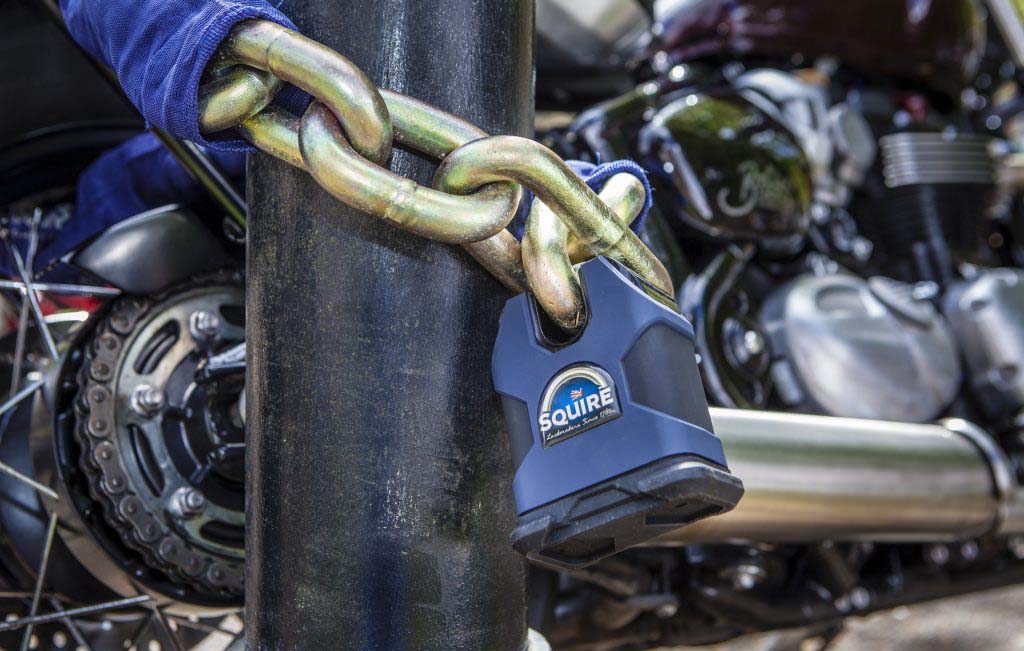Criminals adore motorcycles and scooters.
Not only do they use them to quickly and easily get around and evade capture but they also strip them and sell their parts.
There are a lot of scooters and motorbikes in cities since they make for convenient transportation, but they’re typically easy to steal (owing to the fact that they tend to be less securely protected). They are simple to ride, they can squeeze through tight spaces (helping a getaway), handle pillion riders well, and can carry a scrote’s tools with ease thanks to their enormous underseat and top-box storage.
In addition, there is a substantial second-hand market for parts in the UK and around Europe due to the popularity of scooters.
Installing even the most basic security systems can aid in deterring criminals from stealing your pride and joy.
This guide is designed to help you improve your security and reduce the chances of having your bike stolen.
Additionally, we’ve chosen a few top-rated Amazon-suggested products from well-known manufacturers. We’ve (hopefully) made things simple for you if you don’t have time to do any research.
Learn the best practices for protecting your motorcycle at home, at work, or while you are on the go. These techniques will greatly improve your security with only minimal cost.
Table of Contents
How to choose the right motorcycle security
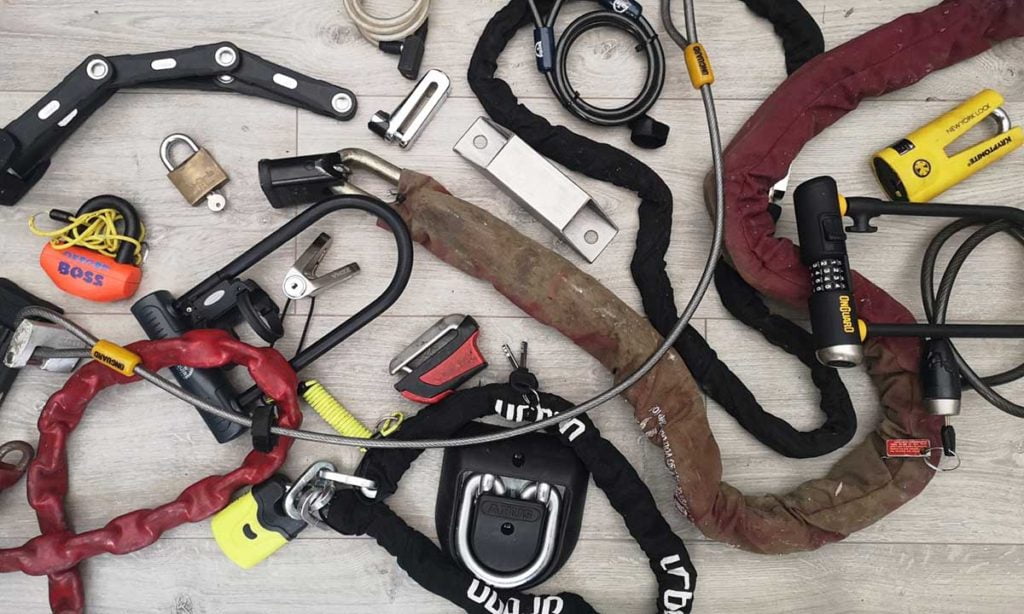
Any additional security is better than none but before you shell out your hard-earned cash, you need to think about the following four important factors:
- Where are you securing your motorcycle?
- Are you securing it during the day or overnight?
- Can you lock your bike to something?
- Does your security need to be portable?
The answers to these questions will help determine where you’re most at risk and what security you should use to counter this risk.
Properly locking your motorcycle: an overview
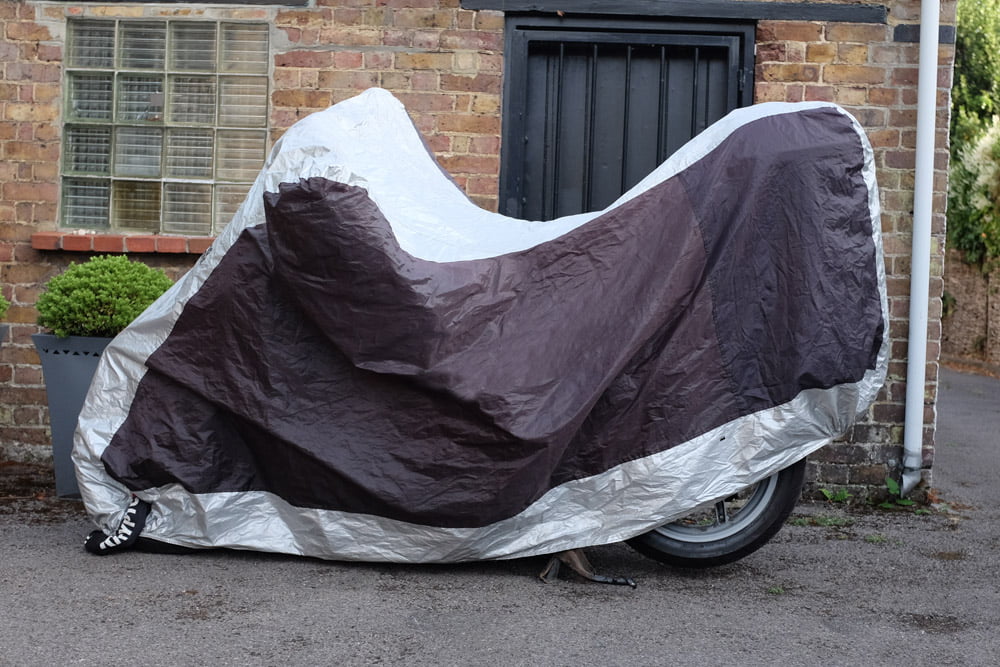
Better security comes in layers. Each layer is an additional step that requires a thief to have more commitment, need more time, and carry more tools. When you use the layering principle, you’re making your motorcycle or scooter a much tougher target.
- Use an alarmed disc lock so that it will sound when it is tampered with.
- Anchor it with a high-quality lock and chain. Do your best to park it somewhere where you can secure your bike to an immovable object.
- Cover it to reduce its visibility to thieves.
Properly locking your motorcycle: in detail
Step 1: Use a disc lock

A disc lock is an excellent portable security measure and it’s easy for anyone to carry either on the bike or in a rucksack. If you can, get one with an alarm as it will provide an additional nuisance for any bike thief.
Even though a high-quality disc lock can be broken, it will require specialist tools. Thieves dislike loud noises, so if they shake your bike to check whether it’s alarmed and the alarm goes off, they’ll think twice.
Step 2: Anchor it

A top-quality security chain (minimum 16mm thick) can’t be bolt-cropped by hand, so thieves will have to use an angle grinder to attempt to cut it.
However, 16mm chains are heavy. Fortunately, for scooter riders, you can sling this in your underseat storage. However, for motorcycle riders, this thickness of chain is hard to carry. The maximum you could realistically transport around is 13mm but 11mm is more viable still.
Whatever chain you use, yuu can lessen the number of tools a thief can use by looping your chain and lock around your seat and around your back tyre, keeping it off the ground. Sledgehammers are useless in this scenario, necessitating the possession of heavy bolt cutters or an angle grinder.
Angle grinders are powerful but they are noisy and spew sparks all over the place. With an angle grinder, it will still take a scrote a couple of minutes to cut through a chain, which might not sound that long but at 3am it will feel like a long time to them and give you time to react.
Although we concede that large chains might be cumbersome and hefty, they are essential for attaching your bike to a permanent object. This will make it harder for thieves to lift your bike directly into the back of their van.
If you leave your bike outside for any period of time, invest in a quality chain and find a good location where you can secure your chain to a fixed object.
Step 3: Cover it
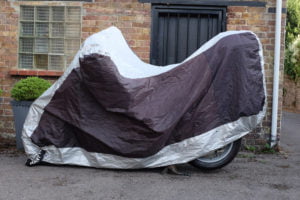
One of the least expensive and most economical types of security is a bike cover. When it comes to the variety of motorcycles available in cities, thieves are spoiled for choice. Spotters will circle their favourite zones, often dressed as Deliverooh rider,s and report the locations of targets.
If your bike is covered, they need to stop, remove the cover, and inspect the bike to know what it is. A cover performs an excellent job of keeping your bike off their list and under their radar because they would prefer not to do this as it draws attention to them.
With a cover costing as little as £20, if you are parking your bike up for a prolonged period of time, it makes sense to use one. Not only do they deter criminals but they also protect your bike from the elements, keeping it in better condition. A bonus!
Which security type is best for me?
I’ve outlined below the various different deterrents and physical security you can use to secure your motorcycle.
Steering Lock
What is it: The steering lock is the lock built into your motorcycle. You activate it by turning your handlebars to the left and twisting your key in the ignition barrel as far to the left as it will go. This slides a pin that’s mounted to the frame over the bike’s steering, preventing it from being easily pushed away .
Best for: Quick and easy security, for example when paying for petrol.
Not great for: Anything other than a very low-level deterrent against theft. A steering lock can be broken in seconds by two thieves. If they bodge the attempt, they can occasionally damage the bike’s frame to the point where your bike gets written off.
D-Lock
What is it: A two-piece lock with one part being a solid D (or U) shaped piece of metal. The other part contains the locking mechanism and housing.
Best for: A D-lock can be a great buy if you want a decent lock to secure your motorcycle security chain when at home but then you need something that’s more portable for when you’re on the move.
Not great for: D-locks aren’t as portable as disc-locks and unlike when being used on a bicycle, they don’t have the size to be able to lock through your motorcycle to something solid.
Security Chain
What is it: Metal linked chains designed to allow you to anchor your motorcycle to a solid object and withstand attack. For high value items like motorcycles, bicycles and caravans, heavy duty chains are frequently utilised as a form of security. In these situations, it’s critical to provide a strong barrier that makes it harder for an attacker to steal your vehicle without specialised tools.
Best for: Ideal for anchoring your motorcycle to a solid object. Quality security chains are heavy which means they are better suited to static security, for example at home or on the street where you don’t have to carry the chain far.
Not great for: Portability. Quality motorcycle security chains needs to be a minimum of 13mm thick but ideally 16mm. A 1.5m chain (the typical length you need to secure your bike to something solid) can weight over 10kg. Not something that’s easy to carry in your rucksack.
Disc Lock
What is it: A lock that you secure to your motorcycle’s brake disc. It prevent the bike from being pushed away.
Best for: Security on the go. A disc lock is small and portable, they can be alarmed too. They’ll require thieves to use specialist tools to remove, which rules out a lot of opportunist bike theft.
Not great for: Long-term outdoor security; a thief may resort to cutting the brake disc to remove the lock and then push your bike away. They also won’t protect against your bike being lifted into a van with locks intact.
Security Cable
What is it: A compact, lightweight lock that you can carry with little hassle. They are flexible, just like chain locks, so many different objects can be attached to them. They are available keyed or with combinations.
Best for: They are a handy way to secure your bike clothing or luggage to your bike.
Not great for: Any form of motorcycle security due to the fact they can easily be cut. Even thick cable locks are just a series of thinner cables twined together. These can just as easily be cut.
Alarm / Immobiliser
What is it: An electronic device that’ll emit a loud alarm, flash your lights and honk your horn if your bike’s disturbed. Often hard-wired into your bike’s wiring loom, they have the ability to immobilise the ignition preventing your bike from being hotwired.
Best for: Best when coupled with a layer of physical security like a disc lock or a chain. An alarm/immobiliser is a good additional layer of security but not a great primary one. If you park your bike outside, an alarm is a great way to gain peace of mind.
Not great for: While an alarm has a role, they’re not a good primary layer of security as there’s no physical barrier to the bike being pushed away or lifted into a van.
Tracker
What is it: A GPS device that can alert you if your motorcycle is being tampered with or moved. It will then send location alerts and can even contact the police on your behalf.
Best for: High-risk theft areas. A motorcycle tracker is a brilliant additional layer of security. Although it might not be visible – and therefore off-putting – to a thief, it can offer an early warning that your motorbike or moped is being tampered with. If your bike is stolen, the tracker will massively improve the chances of you being reunited with your bike.
Not great for: On its own a tracker has limited use as a form of defence against theft. It is a good way of tracing a stolen bike or being warned that a theft is in process but without additional layers of security, a tracker won’t give you the advantage in the minutes leading up to your bike being stolen.
Ground Anchor
What is it: A solid metal loop that’s concreted or bonded to the ground, giving you a secure physical point from which to anchor your bike with a security chain.
Best for: Beefing up your home or garage security or providing a concealed and non-intrusive anchor-point at your place of work.
Not great for: Portability!
The tools thieves use: and how to counter them
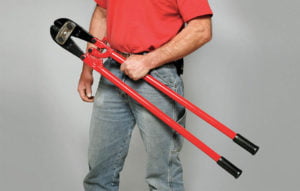
While you might have seen videos of thieves stealing bikes in busy areas in broad daylight, attacking the locks with security while threatening members of the public. It’s almost like it’s from a Hollywood film but it’s worth stressing that this kind of theft, while dramatic, is very rare.
The most common way motorcycles are stolen is when the only security being used is a steering lock, the built-in lock that comes on every motorcycle or scooter.
The sad fact is thieves don’t often have to work very hard to steal a bike, as so many use no – or very poor – security.
However, there are groups and gangs in every corner of the UK who make a living from stealing bikes. These guys are not opportunists. They’ll send scouts out to look for bikes, they know what they’re going for and they’ll be equipped with specialist tools to help them quickly defeat your security.
The quality of your security, the way you use it and how much you use will determine whether or not they even attempt to steal your bike.
These are the most common tools motorcycle thieves use.
1. Their hands
Yes, I admit, they’re not going to be using their feet but most theft occurs without the use of any tools.
If you just use your motorcycle or scooter’s steering lock, thieves can bypass this in seconds.
A few hard bangs of the steering against the lock and it will snap. I have even heard of cases of £10,000 motorbikes being written off when the headstock has snapped instead of the steering lock.
The only time I ever use a steering lock is when I’m paying for petrol.
I don’t use it when I’m using other security when parking my motorcycle when out and about because I don’t want a thief to attack that first, break the lock (or not), and cause me a massive headache and expensive repair bill.
I’d rather they attempted to defeat one of the multiple locks I use, or, more to the point, I’d rather they noted the level of security I use and f***ed off to the next potential target, leaving my bike alone – which to date, they have.
2. Bolt Croppers
Thieves can defeat any cable lock and smaller thickness (11mm and below) chains with bolt croppers. They are easily obtained from any DIY store.
The good news is that any serious D-lock or chain (of a 13mm diameter or thicker) is hard to beat with bolt croppers.
While you could probably crop a 13mm chain link with a set of the largest bolt croppers (42″ long), thieves are less likely to want to carry these. Usually they carry 24″ croppers which will still enable them to beat any cable and cheaper 10mm chains.
The good news is pretty much any decent disc lock is immune to bolt croppers and a good quality chain will present a challenge.
3. Angle Grinders
In the past 10 years, portable grinders have become the thicko-thief’s tool of choice. Unfortunately, there are very few locks or locking methods that will prevent an angle grinder from being effective.
However, that’s not to say you should yield to this annoyingly effective power tool.
An angle grinder makes a lot of noise and sets off a shower of sparks to whatever it is cutting. It is very rare a thief will try and use one in broad daylight. Although as mentioned above, some do.
If you use a good quality disc lock, some thieves will not even attempt to cut the lock, instead they will cut your brake disc on either side of your lock as it’ll be easier to remove.
Some D-locks have double-bolts on the shackle, meaning that a thief will need to cut both sides, which = double the time required.
Also it’s worth noting that if you use better methods of security, i.e. keeping your chain off the ground, fitting your disc lock or U-lock in a hard to access place, a thief won’t have the same easy access or straight-cutting surface to work from. If they can’t access even a cheap £20 disc lock, they won’t be able to cut it.
4. Crowbars & Hammers
Crow bars or pry-bars and hammers are used as much to attack locks as they are to threaten any poor member of the public who tries to step in to help.
If you have a low-quality lock, like a disc lock, padlock or D-lock, these can be broken by hammer attacks or sustained leverage from a crow bar. This type of theft is less common but if a thief is carrying a set of bolt-cutters in their rucksack, they probably also have these other tools to hand.
5. Vans
Is a van a tool? Well for the purposes of this security guide, I’m classifying it as one. Regardless of how much money you spend on a disc lock, if you don’t lock your bike to anything, it can be lifted into the back of a van by a couple of blokes in less than 20 seconds.
Whatever physical security you have on there, they’ll deal with, in the safety of their lock-up. Chains and solid objects win here but also fitting a tracker is a good safety net should the worst occur.
Are Sold Secure locks the best?
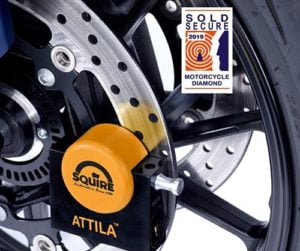
If you don’t know what Sold Secure is, they are an organisation that independelty tests security products. Manufacturers of the products pay Sold Secure for them to carry out their tests. If the products are good, they get awarded a Sold Secure rating. You can read more about this in our Sold Secure ratings guide.
While Sold Secure don’t test every lock on the market, they do test a good range. They have several different ratings depending on what tools are required to beat the lock and how long it takes to beat.
In the motorcycle segment, the ratings are Sold Secure Gold and Sold Secure Diamond.
There will be products out there that aren’t tested by Sold Secure but would exceed their ratings. However you’ll have to have a good dig around to find them. The beauty of Sold Secure is it’s simplicity. So when you’re in your local bike shop or Halfords etc, you can be sure that a product with a Sold Secure rating will offer a decent level of protection.
How much do I need to spend on a decent lock?
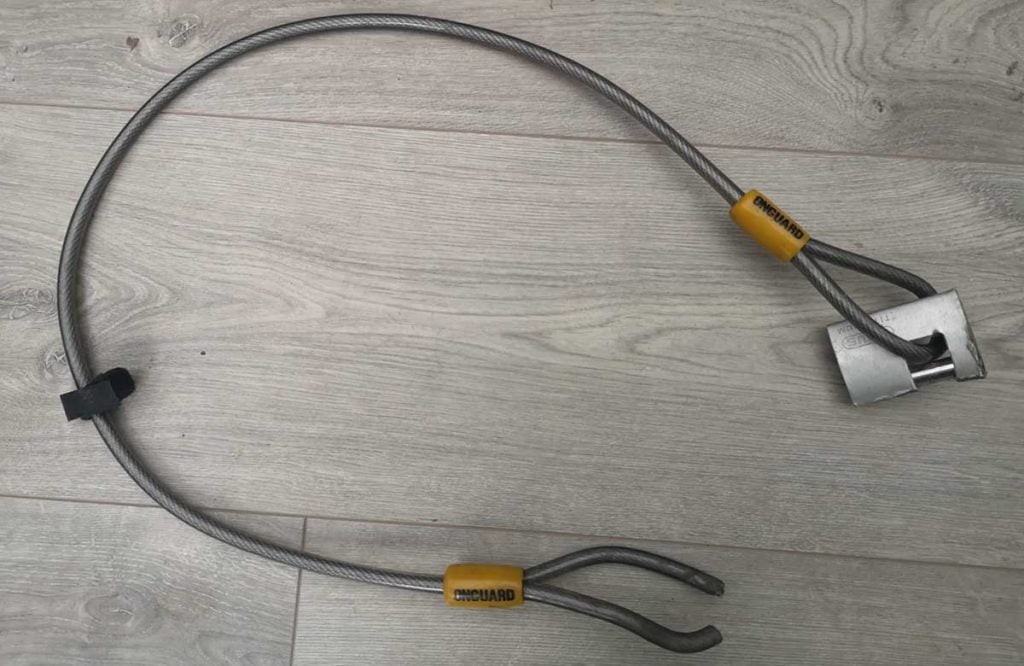
Is there any point in buying a cheap security?
Well yes and no.
If you REALLY can’t afford to spend more than £50 on motorcycle security, then buy the best single piece of security you can afford. For example, a £30 disc lock will withstand a bit of abuse and will deter opportunist theft.
Generally speaking, the more you spend the better your lock will be. A good quick tip is to look for a Sold Secure rating and buy the best you can.
Just remember that cheap locks are usually a false economy. Think about the grief, expense – and time – involved in claiming from your insurance for a stolen bike. Now, do you really think a £20 disc lock is a good idea?
As a general rule, I suggest you spend whatever your insurance policy excess is on security. Most of us have a £250 excess and that £250 buys you a very good disc lock, a decent chain, and a cover. Three layers of security to keep your bike safe and you from having to ever make an insurance claim.
How much do you need to spend? The question really is: Can you afford to have your motorcycle stolen?
Don’t forget to cover it
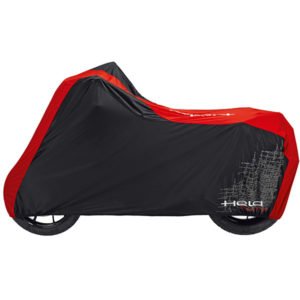
A motorcycle cover costs around £20 and is an excellent layer of security.
If your bike is covered a thief will have to get closer to it in order to figure out what it is. They may need to remove the cover to get a closer look.
They really don’t want to be doing this.
A cover prevents them knowing what your bike is from a passing glance and it stops them from seeing what other security you have. In short, a scummy thief wants an easy life, they don’t want surprises.
When they go to steal a bike, they want as many assurances as possible. They want to know what it is, what security they have to beat, where they’re going to take it and how easily they can sell it. If you introduce some doubt there, they’re just move onto the next target.
Motorcycle Security FAQs
Should I use a cable lock?
No, I’d only use one to secure my clothing or helmet. In a low-risk area, I haven’t had any cause for concern (for example when touring in Europe) but in a city-centre, I wouldn’t want to be away from my bike for more than a few minutes if I was only using a cable lock.
Is an alarm more hassle than it’s worth?
If you’re buying a bike from the 1990s or 2000s and it’s fitted with an alarm, it might be more of a hassle than it’s worth.
There are a number of choices, ranging from straightforward alarms that a knowledgeable home mechanic can install themselves to full immobiliser systems.
Most require that you cut into your bike’s wiring loom and wire in the alarm. This is often where the problems lie, from dodgy connections to water ingress.
I have been on many a rideout where someone’s alarm / immobiliser has decided not to work, leaving them stranded.
Depending on your bike and where you reside, some insurance policies can require a Thatcham-approved immobiliser.
However, while your machine may come with an immobiliser from the factory, some manufacturers don’t use Thatcham-approved systems. KTM are one of these manufacturers.
Yes, a correctly installed alarm can be a genuine deterrent to thieves, but a determined burglar might still steal a bike and peel the panels off to access the loud siren.
While there are plenty of films on social media of alarm systems being ripped out and silenced by thieves, you never see videos of motorcycles that were not stolen because the thief was put off by the warning chirp or by the noise of the alarm going off.
Sources
Thanks to the following websites which helped me research and write this guide:
Protect your motorcycle, moped or scooter from theft | Metropolitan Police
